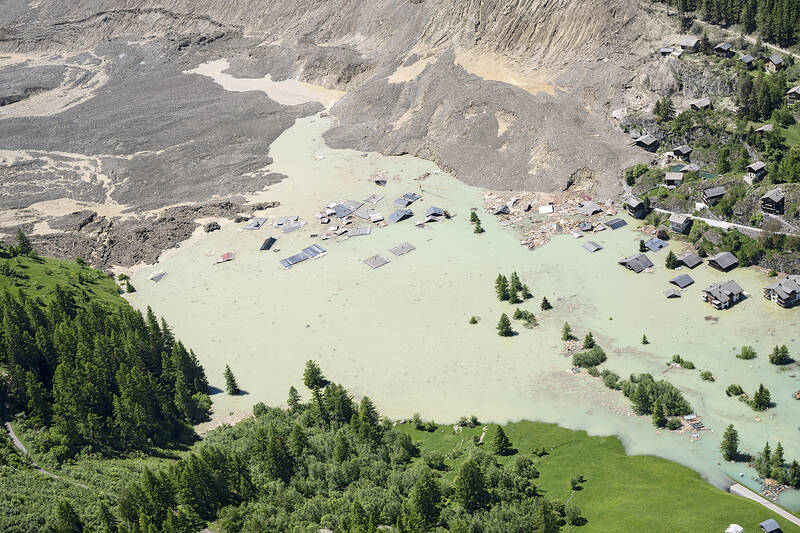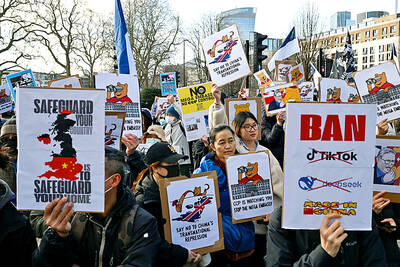The collapse of the Swiss Birch glacier serves as a chilling warning of the escalating dangers faced by communities worldwide living under the shadow of fragile ice, particularly in Asia, experts said.
Footage of the collapse on Wednesday showed a huge cloud of ice and rubble hurtling down the mountainside into the hamlet of Blatten.
Swiss Development Cooperation disaster risk reduction adviser Ali Neumann said that while the role of climate change in the case of Blatten “still needs to be investigated,” the wider impacts were clear on the cryosphere — the part of the world covered by frozen water.

Photo: EPA-EFE
“Climate change and its impact on the cryosphere will have growing repercussions on human societies that live near glaciers, near the cryosphere, and depend on glaciers somehow and live with them,” he said.
The barrage largely destroyed Blatten, but the evacuation of its 300 residents last week averted mass casualties, although one person remains missing.
“It also showed that with the right skills and observation and management of an emergency, you can significantly reduce the magnitude of this type of disaster,” Neumann said at a UN-backed glacier conference in Tajikistan.
World Meteorological Organization director for hydrology, water and cryosphere Stefan Uhlenbrook said it showed the need for vulnerable regions such as the Himalayas and other parts of Asia to prepare.
“From monitoring, to data sharing, to numerical simulation models, to hazard assessment and to communicating that, the whole chain needs to be strengthened,” Uhlenbrook said. “But in many Asian countries, this is weak, the data is not sufficiently connected.”
Swiss geologists use various methods, including sensors and satellite images, to monitor their glaciers.
Asia was the world’s most disaster-hit region from climate and weather hazards in 2023, the UN said last year, with floods and storms the chief cause of casualties and economic losses.
However, many Asian nations, particularly in the Himalayas, lack the resources to monitor their vast glaciers to the same degree as the Swiss.
A 2024 UN Office for Disaster Risk Reduction report said that two-thirds of countries in the Asia and Pacific region have early warning systems, but the least-developed countries, many of whom are in the frontlines of climate change, have the worst coverage.
“Monitoring is not absent, but it is not enough,” International Centre for Integrated Mountain Development geologist Sudan Bikash Maharjan said. “Our terrains and climatic conditions are challenging, but also we lack that level of resources for intensive data generation.”
That gap is reflected in the number of disaster-related fatalities for each event.
While the average number of fatalities per disaster was 189 globally, in Asia and the Pacific it was much higher at 338, according to the Centre for Research on the Epidemiology of Disasters’ Emergency Events Database.
Geoscientist Jakob Steiner, who works in climate adaptation in Nepal and Bhutan, said it is not as simple as just exporting the Swiss technological solutions.
“These are complex disasters, working together with the communities is actually just as, if not much more, important,” he said.
Himalayan glaciers, providing critical water to about two billion people, are melting faster than ever due to climate change, exposing communities to unpredictable and costly disasters, scientists warned.
Hundreds of lakes formed from glacial meltwater have appeared in recent decades. They can be deadly when they burst and rush down the valley. The softening of permafrost increases the chances of landslides.
The Asian Development Bank’s Climate Change and Sustainable Development Department economist Declan Magee said that monitoring and early warnings alone are not enough.
“We have to think... about where we build, where people build infrastructure and homes, and how we can decrease their vulnerability if it is exposed,” he said.
Nepalese climate activist and filmmaker Tashi Lhazom described how the village of Til, near to her home, was devastated by a landslide last month. The 21 families escaped — but only just.
“In Switzerland they were evacuated days before, here we did not even get seconds,” Lhazom said. “The disparity makes me sad but also angry. This has to change.”

BOMBARDMENT: Moscow sent more than 440 drones and 32 missiles, Volodymyr Zelenskiy said, in ‘one of the most terrifying strikes’ on the capital in recent months A nighttime Russian missile and drone bombardment of Ukraine killed at least 15 people and injured 116 while they slept in their homes, local officials said yesterday, with the main barrage centering on the capital, Kyiv. Kyiv City Military Administration head Tymur Tkachenko said 14 people were killed and 99 were injured as explosions echoed across the city for hours during the night. The bombardment demolished a nine-story residential building, destroying dozens of apartments. Emergency workers were at the scene to rescue people from under the rubble. Russia flung more than 440 drones and 32 missiles at Ukraine, Ukrainian President Volodymyr Zelenskiy

‘SHORTSIGHTED’: Using aid as leverage is punitive, would not be regarded well among Pacific Island nations and would further open the door for China, an academic said New Zealand has suspended millions of dollars in budget funding to the Cook Islands, it said yesterday, as the relationship between the two constitutionally linked countries continues to deteriorate amid the island group’s deepening ties with China. A spokesperson for New Zealand Minister of Foreign Affairs Winston Peters said in a statement that New Zealand early this month decided to suspend payment of NZ$18.2 million (US$11 million) in core sector support funding for this year and next year as it “relies on a high trust bilateral relationship.” New Zealand and Australia have become increasingly cautious about China’s growing presence in the Pacific

Indonesia’s Mount Lewotobi Laki-Laki yesterday erupted again with giant ash and smoke plumes after forcing evacuations of villages and flight cancelations, including to and from the resort island of Bali. Several eruptions sent ash up to 5km into the sky on Tuesday evening to yesterday afternoon. An eruption on Tuesday afternoon sent thick, gray clouds 10km into the sky that expanded into a mushroom-shaped ash cloud visible as much as 150km kilometers away. The eruption alert was raised on Tuesday to the highest level and the danger zone where people are recommended to leave was expanded to 8km from the crater. Officers also

ESPIONAGE: The British government’s decision on the proposed embassy hinges on the security of underground data cables, a former diplomat has said A US intervention over China’s proposed new embassy in London has thrown a potential resolution “up in the air,” campaigners have said, amid concerns over the site’s proximity to a sensitive hub of critical communication cables. The furor over a new “super-embassy” on the edge of London’s financial district was reignited last week when the White House said it was “deeply concerned” over potential Chinese access to “the sensitive communications of one of our closest allies.” The Dutch parliament has also raised concerns about Beijing’s ideal location of Royal Mint Court, on the edge of the City of London, which has so